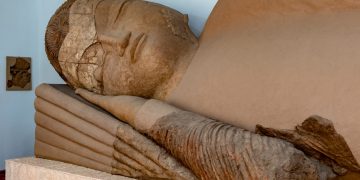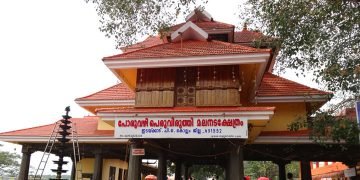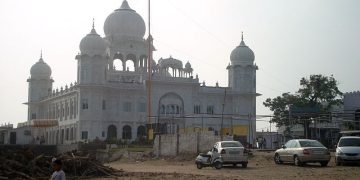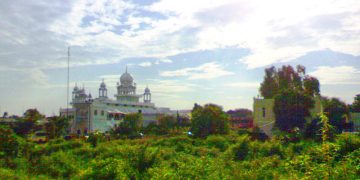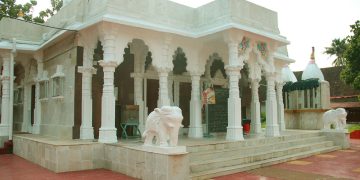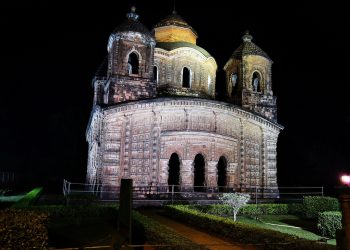Vimala Temple or Bimala Temple is a Hindu temple dedicated to goddess Vimala , located within the Jagannath Temple complex in Puri in the Indian state of Orissa. It is generally regarded as a Shakti Pitha, among the holiest temples dedicated to the Hindu Goddess.
Shrine’s History
The central icon of Vimala is of sixth century CE. The present structure, based on its architecture, seems to have been built in the ninth century under the Eastern Ganga dynasty, possibly over ruins of an earlier temple. Its architecture is similar to the shrine of Narasimha near the Mukti-mandapa in the Jagannath temple complex, dated to the ninth century. The Madala Panji states that the temple was constructed by Yayati Keshari, a ruler of Somavashi Dynasty of South Kosala. Kings Yayati I and Yayati II are known by the title Yayati Keshari. The sculptures, especially the parshvadevatas (attendant deities), as well as the background slab of the central icon, reflect the Somavashi style and may be part of the original temple, on whose ruins the new temple was constructed.
Vimala is believed to have preceded even the central Jagannath shrine. Hindu philosopher and saint Adi Shankara are believed to have established Govardhana matha in Puri, with Vimala as its presiding goddess. According to Starza, the Jagannath Temple was once a centre of worship for the Trimurti of Brahma, Vishnu and Shiva, along with their consorts and the three central forms of the Hindu Goddess, Sarasvati, Lakshmi and Parvati (in the form of Vimala).
The Shri Vidya sect devoted to Goddess worship was strong here until the 17th century. Slowly, Shri Vidya and Shiva-centric Shaiva traditions were eroded but remnants continue, with the Vishnu-centric Vaishnavism becoming the sole tradition. The Tantric Panchamakara, which includes fish, meat, liquor, parched grain and ritual intercourse, were replaced with vegetarian offerings and dance of devdasis. Fish was caught locally and offered to the goddess. King Narasimhadeva, who ruled between 1623?47, ended the meat and fish offerings of the goddess, although the tradition was later partly revitalised. Today, the goddess is offered meat and fish on special days.

Legends Associated with This Shrine
The Vimala Temple is considered one of the Shakti Pithas, the most sacred temples of the Hindu Goddess, identified with Parvati or Durga as the consort of the god Shiva. It is considered to be a prime example of the importance of the Shakti cult in Orissa. It is customary to worship Shiva at each Shakti Pitha in the form of Bhairava, the male counterpart or guardian of the presiding goddess of the Shakti Pitha. In Goddess-oriented worship, Vimala is regarded as the presiding goddess of the Purushottama Shakti Pitha.
Jagannath, a form of the god Vishnu/Krishna, is worshipped as the Pitha’s Bhairava. This is a departure from the usual tradition of Bhairava as a form of Shiva. So, in this temple complex, Vishnu?one of the Hindu trinity?is equated with Shiva, another of the trinity; this is interpreted to convey the oneness of God. In this regard, Vimala – generally associated with Shiva’s consort – is also considered as Lakshmi, the consort of Vishnu. Conversely, Tantric consider Jagannath as Shiva-Bhairava, rather than a form of Vishnu. The main sanctum of the Jagannath Temple has three deities: Jagannath, Balabhadra and Subhadra.
In Jagannath-centric traditions, while Lakshmi is the orthodox consort of Jagannath in the temple complex, Vimala is the Tantric (heterodox) consort and guardian goddess of the temple complex. Vimala is identified with the goddesses Katyayini, Durga, Bhairavi, Bhuvaneshvari and Ekanamsha in various texts and rituals. She is considered the shakti of Vishnu as well as Shiva in the climactic Durga Puja festivities in the temple. She appears as Mahishasuramardini (Durga as a slayer of the demon Mahishasura) or Vijayalakshmi (the warrior form of Lakshmi) in New Delhi Konark stele, 13th century stone stele originally from Konark Sun Temple and now housed in National Museum, New Delhi.
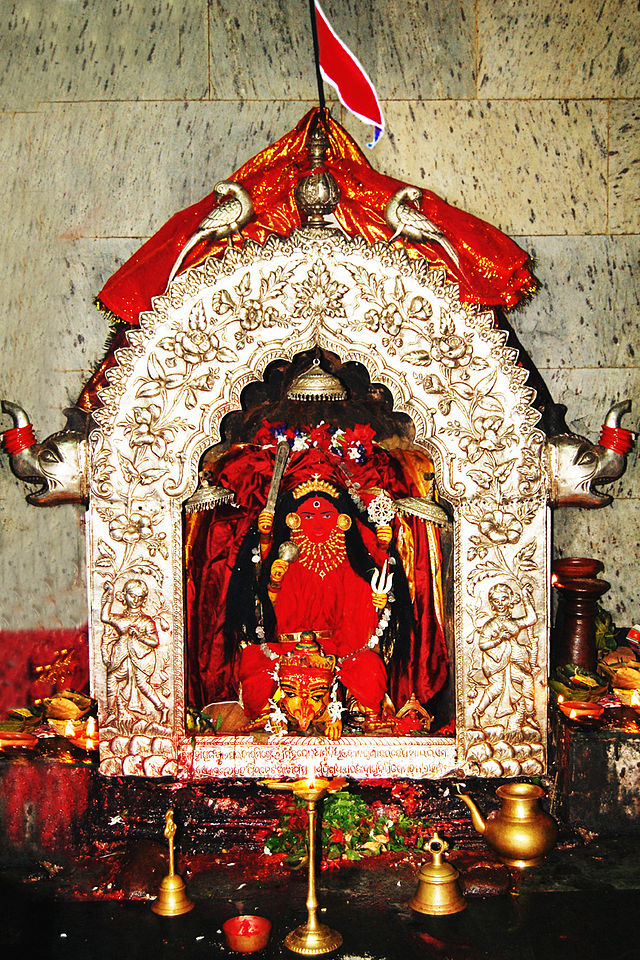
Architectural Relevance of This Shrine
The temple is located in the south-west corner of the inner enclosure of the Jagannath temple complex and on the right-hand western corner of the tower of Jagannath, next to the sacred pond Rohini kunda. The temple faces east and is built of sandstone and laterite. It is built in the Deula style that has four components namely, vimana ( the structure containing the sanctum), jagamohana , nata-mandapa and bhoga-mandapa (hall of offerings).
The temple is maintained and was renovated around 2005 by the Archaeological Survey of India, Bhubaneswar Circle. Vimana The vimana is a Rekha deula (a tall building with a shape of sugarloaf), 60 feet in height and in a shape of 15 feet square. It stands on a 2 feet platform, which is decorated with lotus and other floral designs and scrollwork. The outer wall of the vimana is divided into 5 parts : pabhaga, talajangha, bandhana, upara jangha and baranda. The niches and intervening recesses of the first part of the wall are ornate, with khakhara mundis , scrollwork, floral designs, creepers, love-making couples and Nagas (serpent-men).
The niches and intervening recesses of the second part of the wall are also decorated with khakhara mundis, simhavidalas, Gajavidalas (an elephant-faced lion trampling a lion), jaliwork, scrollwork, sikshadana scene (sages teaching disciples) and kirtimukha (a monster face) motifs, along with the figurines of eight Dikpalas (guardian gods of the directions) and some goddesses. The third part of the outer wall has two horizontal mouldings decorated with alasa-kanyas (beautiful human maidens), scrollwork and floral and lotus motifs. The niches and recesses of the fourth part of the wall are decorated with pidha mundis (a type of niche), simhavidalas, erotic scenes, alasa-kanyas, scrollwork, jaliwork and floral designs, along with figures of the consorts of the Dikpalas, Nagas and their female consort Naginis and various goddesses.
The Dikpalas and their consorts are seen with their mounts and aligned to their respective directions.Images of the parshvadevatas are placed in the central niches of the outer wall (bada) on three sides: the eight-armed Durga slaying Mahishasura on the south; the six-armed goddess Chamunda standing on Shiva on the west and an empty niche on the north, which probably had a goddess figure that was stolen. The lintel of the attendant deity niche has Gaja Lakshmi figurines. The frames of the niches are decorated with scrollwork and kirtimukha motifs and two female attendants accompany each niche. The uppermost part of the outer wall has ten horizontal mouldings, ornate with scrollwork, kirtimukha and lotus and floral motifs.
Within the vimana lies the garbhagriha (sanctum), which is topped with a pancharatha-style, curvilinear temple pinnacle. The goddess Vimala is deified within the sanctum, the sixth-century inner chamber that is devoid of wall decorations.The central icon of Vimala holds a rosary in the upper right hand. Her lower right hand is held in a boon-giving gesture and her lower left holds a pitcher, considered to be filled with amrita(celestial elixir of life). The attribute in the upper left hand is heavily disputed.
Descriptions include a human figurine, a nagini, a mermaid, a naga-pasha (serpent-noose) or some other object. She holds no weapons normally attributed to Durga. The icon is installed on a simhasana (lion-throne), adorned with the figures of the goddess’ female attendants Chhaya and Maya on the sides. The image is said to be made of lakha (a type of wax) and slightly taller than 4 feet. The sanctum door, with a flight of stairs, leads down to the jagamohana. The lintel has the Gaja Lakshmi figurine in the centre surrounded with apsaras . The Navagraha (deities of the classical planets) are carved above the lintel. The doorjambs are decorated scrollwork, creepers, flowers and boys playing. Two gate-keeper sculptors surround the door. Jagamohana The jagamohana or mukhasala is a pidha deula (square building with a pyramid-shaped roof), 35 feet (11 m) in height with 25 feet (7.6 m) square base. It stands on a 2 feet (0.61 m) high platform, which is decorated with floral designs and scrollwork. The outer wall is divided into 5 parts, as in the vimana. The niches and intervening recesses of the first part are adorned with Khakhara mundi niches (having amorous couples and erotic scenes), Naga pilasters, scrollwork, jaliwork and floral motifs. The talajangha has the same motifs as the vimana’s second part of the wall, barring the goddesses. The third part of the wall has three horizontal mouldings. The fourth part of the wall also resembles its counterpart in the vimana, except it does not have the Naga and goddess sculptures.
The uppermost part of the wall has seven horizontal mouldings, the central portion of which is decorated with dancing women, amorous couples, elephants, deer, scrollwork and jaliwork. The gavaksha (decorative arch) on the northern and southern sides are royal court and sikshadana scenes, with a balustraded window on each side. The frames of the windows are decorated with scrollwork, jaliwork, playing boys, floral designs, creepers and dancing women. The structure is topped with a pyramidal shikhara. The inner walls have no ornamentation. The jagamohana has two doorways: one towards the sanctum (already discussed in vimana section) and other towards the natamandapa, which is similar in style and decoration to the former. Natamandapa The natamandapa is a pidha deula, 22 feet in height and in the shape of rectangle 35 feet (11 m) in length by 18 feet (5.5 m). It is probably a later addition to the original temple, which consisted of the vimana and jagamohana.
It stands on a 3.5 feet (1.1 m) platform. The five divisions of the outer wall are undecorated. It is topped with a small pyramidal pinnacle. The natamandapa has four doorways, one on each side of the wall. Inner walls of the natamandapa are adorned with Pattachitra-style traditional Orissan paintings, depicting sixteen forms of the Hindu Goddess, including the Mahavidyas. Bhogamandapa The bhogamandapa is a pidha deula, 20 feet (6.1 m) in height and in the shape of 15 feet (4.6 m) square. It stands on a 4 feet (1.2 m) platform. The five outer wall divisions are undecorated. It is topped with a small pinnacle.
An eight-armed dancing Ganesha and a 12-armed, six-headed standing Kartikeya occupy niches on the western inner wall. The ceiling has floral paintings with a lotus design in the middle, suspending downwards.[clarification needed] The bhogamandapa has four doorways, opening on each side. Two female gatekeepers guard each door. A flight of steps at the eastern doorway serves as the main entrance of the temple. At the entrance to the shrine outside the bhogamandapa, there are 4 feet Gaja-Simha, the lion ? the goddess’ vahana ? riding an elephant, symbolizing the victory of good over evil. It is covered by a flat roof.
Shrine’s Map Location and How to Go There
By Road
Mini buses run by the state transport department connect Puri with Bhubaneswar while jeeps are available to and from Konark. There are two bus terminuses within the city at Baramunda and opposite Ashok hotel while private buses are also available at the junction of Grand Road and Hospital Road.
By Rail
By Rail:- Puri has its own railway station which connects it to cities such as Kolkata, New Delhi, Ahmedabad and Vishakhapatnam while Bhubaneswar is also connected to most of the major Indian cities.
By Air
The nearest airport is located at Bhubaneswar. which 56 km away.
Shrine Timings
Open 7:30 am Close 7:30 pm
Extra Information About this Shrine
Some consider this sakthipeeth to be atViraja Shakti peeth, which is located at Jajpur of Orissa
Accommodation:- Puri, the land of Lord Jagannathji is been well known for its pristine beaches, colourful festivals, and the numerous points of tourist attraction. Every year millions of tourists across this globe come here for leisure, pleasure, and devotion. The Jagannathji Temple Administration has kept in mind the needs of the devotees, has come up with Nilachal Bhakta Nivas? a brand new guest house. Right on the Grand Road and adjacent to the temple, the guest house has great locational advantages. It is only minutes away from the railway station, bus stop and the beach.



